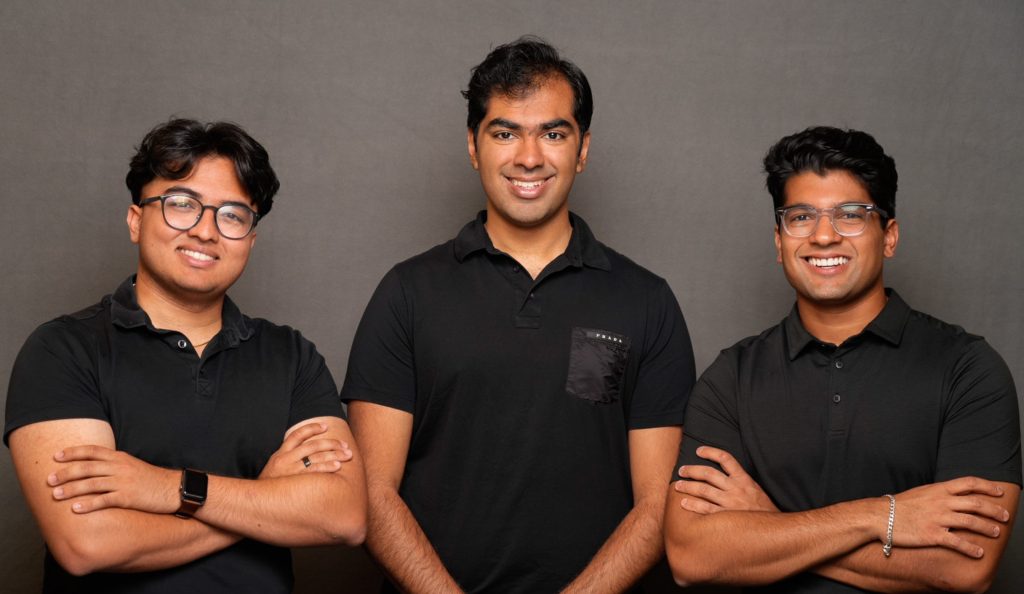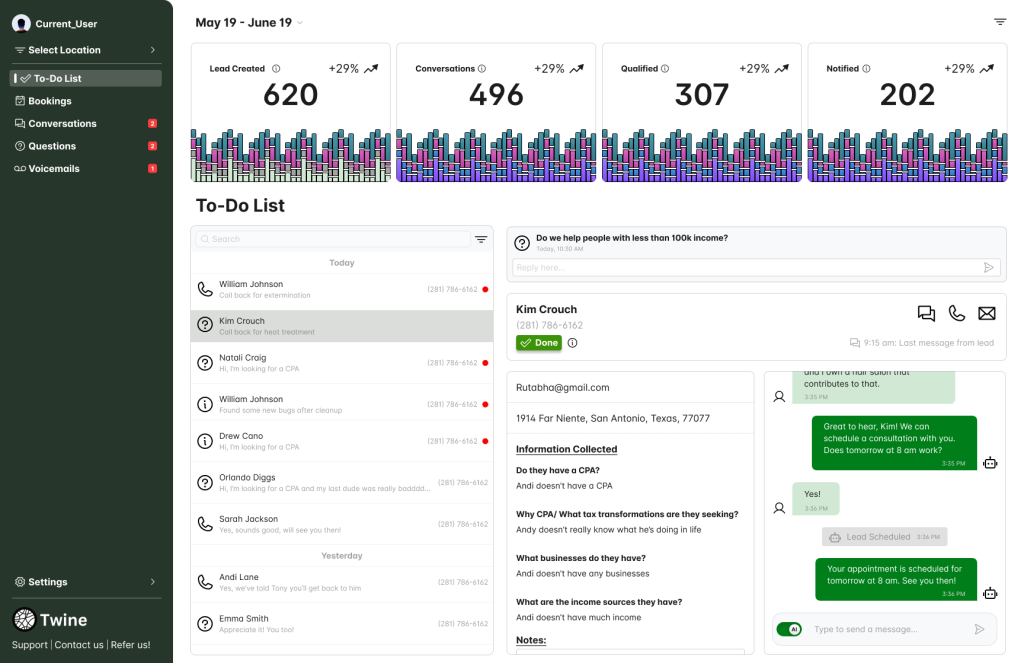For small businesses, every missed call is a lost opportunity. Twine ensures that never happens by turning unanswered calls into instant text conversations, automating follow-ups, scheduling, and even payments. But it goes beyond missed calls—Twine acts as a digital receptionist, integrating with CRMs, managing leads, and helping businesses stay competitive. Co-founder Divyesh Khatri shares how a mid-Y Combinator pivot led to a product that streamlines operations and keeps small businesses thriving.

From left: Divyesh Khatri, Omar Imtiaz, Anand Valavalkar.
1. What inspired the creation of Twine, and how does it address the critical problem of missed business opportunities due to missed calls?
Divyesh Khatri: I started Twine with my best friend from middle school, Omar, and his good friend from college, Anand. We were all in our junior year of college. Despite having internships lined up for the summer, we figured this was the last “free time” to pursue our dreams of starting a startup before we went off into the real world. So we hunkered down, rescinded our internship offers, and started thinking about ideas. We originally settled on an app that enabled you to semantically search over all of your texts, emails, etc (effectively inter-Twine-ing your communications into a central platform). The inspiration behind this idea came from Anand’s struggles as a networking contractor — a business he scaled to $100k in revenue while only using iMessage as his communications and CRM hub. He often found himself in a web of searches in order to find specific conversations and figured this product would help him save a lot of time. We ended up getting into YCombinator with this idea, but when it came to selling the product to local businesses, we found it difficult to communicate the value of the product. Four weeks into the batch, we decided to pivot — and we took inspiration from the DoorDash founders when they were trying to find a product. They called 100 local businesses to figure out what problems they needed to solve. But we quickly realized a problem when just 20 out of 100 businesses picked up, and only 10 businesses tried following up with us. This inspired us to dig deeper into the problem and realize that businesses that follow up immediately have a 4x chance of converting a customer than businesses that take 30 minutes to follow up. And businesses that realize this end up not even trying to call people back because they’ve often moved on to another customer. We designed an AI agent that texted customers as soon as a business missed a call, had a conversation with them, and converted them into a paying customer. As soon as we launched this product, we got immediate interest and had a much easier time selling than the first product.
2. Twine transforms missed calls into instant text conversations. What core features make Twine stand out as an AI-powered receptionist?
Divyesh Khatri: Honestly, we have so many. Since we started, we’ve added scheduling to coordinate finding a time on the calendar, web form integration to instantly message customers who fill out a form on your website, multi-location routing to find out where the customer is and then route them to the location of the business that covers them, Google LSA Messaging and Calls to find out the contact details of leads whose identities are hidden from you by Google LSA, call notetaking to take notes on leads for you on a call and auto-format the information collected to push into your CRM automatically, HIPAA certification to help us serve medical practices, specialty clinics, dentists, and much more, and reviews—the AI helps us automatically reach out and ask for feedback. Any negative feedback gets directed back to the business owner while responding empathetically to their customers, and positive feedback gets encouraged to leave a review.
3. How does Twine integrate with existing business tools like VOIP systems and personalized dashboards?
Divyesh Khatri: It’s quite simple to integrate into a phone system — a simple feature called “conditional call forwarding” allows us to receive any overflow calls (missed/busy) from nearly any phone system. In terms of dashboards, we provide statistics on how far conversations are going. Despite us having an internal UI designed as a checklist for our clients to keep track of which conversations they’ve addressed, our clients end up finding our intelligent SMS notifications the most useful. They receive a text with summarized info about the lead and call them from there.
4. Twine offers a fully customizable conversational AI. How does this personalization enhance the customer experience?
Divyesh Khatri: Every business requires a different setup. Some businesses want to schedule customers for specific calls, others want us only to schedule calls during a certain time during the day, different sales tactics and qualifying questions are often used to build value in the end customer’s head, and there are cases where customers are treated differently depending on what services they need. All of this is easily customizable, and there’s no burden of setup required on the business’s end. They have to take a single call with us where we ask them all these questions, ask for any sales scripts, and adapt the AI to their use case. There’s a testing period where we receive feedback and tweak the AI, and from there, it’s pretty much smooth sailing with minimal hiccups. Our customers are astounded by how well it works and sounds just like them!
5. Twine boasts the ability to capture and respond to every lead instantly. What has been the measurable impact of this feature on your customers’ businesses?
Divyesh Khatri: For one of our clients, a bed bug extermination business, we increased his closing rate from 30% to over 40%. This means — he had a better chance of closing customers when he missed their call, had the AI qualify them over SMS, and called them at a later time rather than just picking up their call in the first place. We figure this is because the AI acts as a helpful qualification tool that can consistently build value for his services. By the time he calls them, they’re primed to buy. There’s a statistic about having multiple touch points with customers increasing your close rates — and we figure that’s what’s at play here.
Another national business we work with had customers filling out forms to reach them. Only 20% of customers ended up picking up their phone calls, and it was because they were so busy they often only saw these form responses in their email well after the customer was active and looking for services. Between 30 minutes and 2 hours and even the next day was normal for response times. Once we started reaching out instantly to people who filled out forms, engagements jumped from 20% to 80% — and we also saved a lot of time by directly sending leads out to their contractors.

6. What role does AI play in Twine’s ability to process payments and follow up with customers for reviews?
Divyesh Khatri: The AI helps us automatically reach out and ask for feedback. Any negative feedback gets directed back to the business owner while responding empathetically to their customers, and positive feedback gets encouraged to leave a review. Once a job is complete, a simple payment link powered by Stripe is sent based on standardized quote templates for services.
7. As a Y Combinator startup, how did the program shape Twine’s development and growth strategy?
Divyesh Khatri: It definitely forced us to get into a rapid pace of going into the market and gathering feedback. Every week we did some big thing in order to talk to potential customers. This is how we quickly realized our first product wasn’t working — no one really wanted the product despite our best efforts to try to get even one demo over the line. When we decided to pivot, our partners gave us pretty good advice on coming up with a new idea, and there wasn’t really any shame about pivoting in the middle of the batch since many YC companies like Scale AI and Brex pivoted in the middle of their batches and became unicorns. After we pivoted, the pressure was on to match the breakneck speed of our batchmates. One week, we had a hunch that private drivers might need a solution to handle missed calls since they don’t want to pick up phone calls while driving. We drove over to SFO and hopped into the private lot for TCP drivers, brought around donuts and coffee, and just tried talking to them about missing calls. We got some of them to pay us $50/month, and that’s how we got some of our first paying customers! I firmly believe that the intensity that YC forced upon us for 10 weeks was formative. Without them, I’m not sure we would even have a company.
8. Twine focuses on service-based small businesses. How have you tailored your AI solution to cater specifically to this market?
Divyesh Khatri: Honestly, one of the biggest things we’ve realized is that simplicity is key in this market. A mobile app is good, and you can design catered experiences, but it’s always going to be a learning curve for the user. This is especially true for busy service professionals already juggling a hundred different things while operating their business. That’s why we figured having the AI text them updates was the best way to reduce friction from a UX perspective. Despite having developed advanced analytics, a mobile app, and a checklist-based UI, SMS notifications are still the main way our users interface with our application.
Another opportunity we realized is that many of our users don’t really use a CRM because it’s cumbersome to record data, especially when they have to take calls in the middle of a job when they can’t take notes. By relying only on memory, some deals were falling through, conversion rates weren’t being tracked, and data was missing that could’ve identified specific areas for growth. So we devised a system that acts as an automatic CRM — importing call transcripts automatically from VOIP systems like CallRail (or our native phone system on the mobile app), tracking conversations, marking when jobs are scheduled, collecting reviews after a job is done, and following up with customers that didn’t convert. It’s already proven to be saving a ton of time for the customers we’ve piloted it with and enabled them to focus on growing their business rather than getting bogged down in operations.
9. What challenges did you face while developing Twine, and how did you overcome them?
Divyesh Khatri: Honestly, it was just a bunch of grit all the way through. We live by the mantra that action breeds clarity. Any time we were lost, we just tested the hypothesis in the market. We collected revenue for things that were just ideas; we went to businesses directly in person, and we did anything we could do to make sure we were testing our ideas as fast as possible and with as much clarity as possible.
10. What personal sacrifices or pivotal decisions have shaped your journey as founders of Twine?
Divyesh Khatri: The biggest moment was pivoting in the middle of the YC batch. We were nearly halfway through, and we realized that the product we were building had no real market viability. Feeling lost during that week when we had no idea while our batchmates were chugging along with their ideas certainly felt like one of the toughest spots we could have been in. We went on a very long walk all the way from our apartment on 8th and Market Street all the way down to the Ferry building, just talking about our visions for the world. Our whiteboards were full of market maps, but eventually, we found clarity in our current idea and haven’t looked back since. Even though the decision to pivot was extremely hard, it was necessary to let go of it in order to be where we are now.
11. What does success look like for you and Twine in the next 5–10 years?
Divyesh Khatri: We’ve noticed a trend of small businesses no longer really becoming small businesses — your mom-and-pop dentist, barber, plumber, HVAC, pest control, etc., are all rolling up into private equity brands or larger franchises. As these businesses become less sexy for young people, they no longer get passed on from generation to generation, and we’re losing the sense of community and trust that comes from getting services from your neighbour. We strongly believe that by bringing software in to manage the mundane, we can make these businesses more exciting to maintain and stay owner-operated. We’re building the tools to make these businesses competitive against the private equity rollups and franchises of the world. By reducing the operational load on businesses, we eliminate staffing issues and ensure they can scale revenue while keeping their costs low. Suppose we can even make a dent in the small business landscape by allowing them to stay owner-operated. In that case, we think we are making the world a better place. Make small businesses small again!
12. What does a typical day look like for the Twine team, and how do you stay motivated?
Divyesh Khatri: Honestly, it’s usually waking up, taking calls, cold-calling businesses, building products, going to the gym, winding down, and doing it all over again. We all live and work out of the same apartment in SF, so feedback is quite immediate between each other. We have a lot of honest conversations about what our priorities should be for the week, and we can’t hide from the metrics we display on the TV in our living room.
Editor’s Note
For Divyesh Khatri, Twine isn’t just fixing missed calls—it’s changing how small businesses engage customers and close deals. From instant AI follow-ups to seamless CRM automation, Twine removes friction and helps businesses scale without added complexity. But at its core, it’s about keeping independent businesses competitive in a landscape increasingly dominated by corporate giants. If Twine succeeds, missing a call will never mean losing a customer again.



